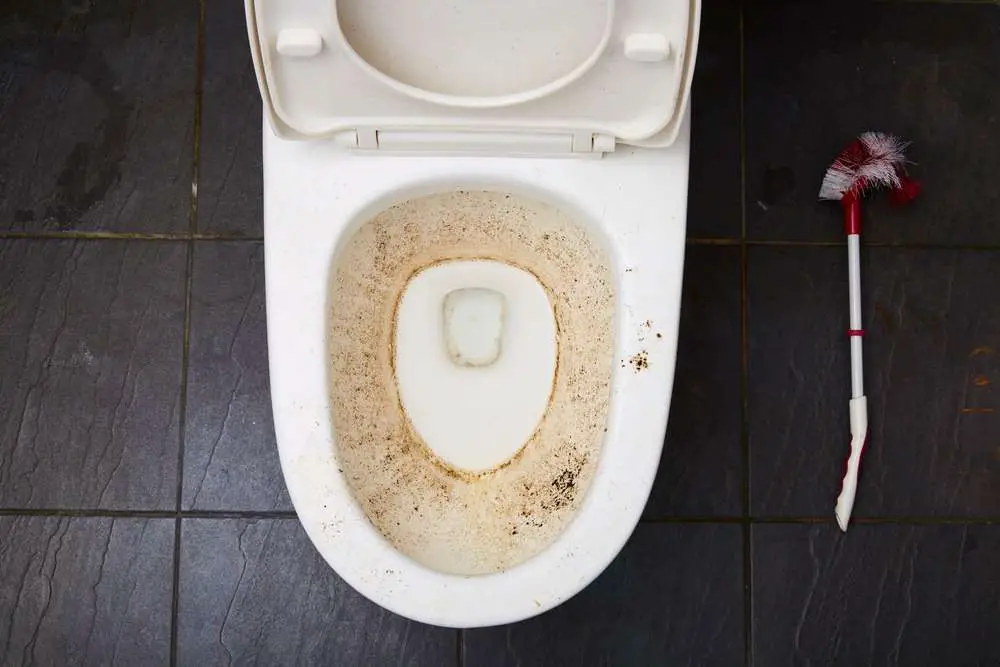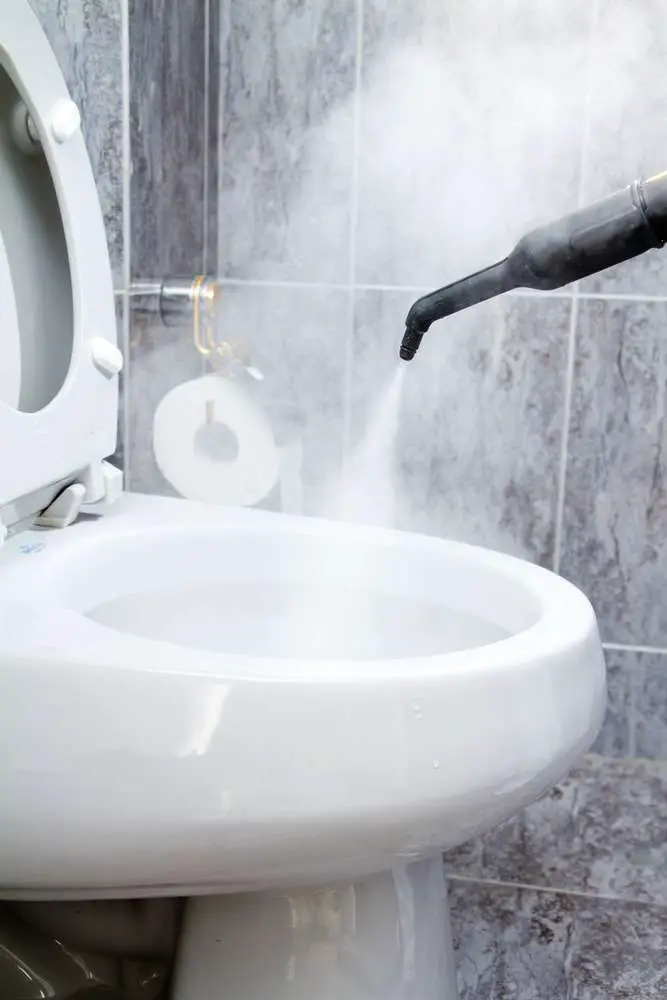- You are here:
- Home »
- Blog »
- Mold Advice »
- 3 Effective Ways to Get Rid of Mold in Your Toilet Bowl
3 Effective Ways to Get Rid of Mold in Your Toilet Bowl

Are you having trouble with mold growth in your toilet bowl? An uncleaned and unused toilet is one of the most common places where the fungus grows. It provides mold with all the conditions it needs to grow and spread. Leaving many homeowners wondering how they can get rid of mold from their toilet bowls.
There are various ways to get rid of mold from your toilet bowl. The 3 most effective ways are steamer and vinegar, bleach, or hydrogen peroxide. The process differs slightly with each, but easy. You can pick either one, depending on which items you have available to you at home. All three will immediately get rid of mold and help prevent further growth, as long as you clean the toilet regularly.
Before we get into the cleaning process, let’s look at the reasons why mold forms on toilet bowls.
Table of contents
What causes mold in a toilet bowl?
Mold grows in certain conditions. The 2 main requirements are water and oxygen. You will find that fungus grows in areas where humidity is high because of dampness in the air.
Bathrooms, generally, have high levels of humidity. They tend to be compact, with limited ventilation, and a high volume of water flow. Let’s also note the stagnant water in the toilet tank and bowl. Mold grows and thrives under these conditions.
But you won’t find mold growing in every toilet bowl. As long as you frequently use it and clean it, the fungus won’t grow. However, if you were to leave it unused and unclean for a period, mold starts to grow.
The toilet tank and bowl surfaces provide enough nutrient source, when water is present, for fungus growth.
Mold can also transfer from water pipes to your toilet bowl. The rust on pipes results in condensation as water flows through them, leading to black mold. The mold then spreads from the rusted pipe to other parts of the bathroom it interacts with: as long as the conditions it needs to grow are met.
Is mold in a toilet bowl dangerous?
Mold, in general, is dangerous for your health. According to the Environmental Protection Agency (EPA), fungus produces irritants and allergens that cause problems when you inhale them or come into contact.
Mold exposure can result in the following:
- Fever and runny nose
- Constant sneezing
- Red eyes
- Skin rash
- Nose bleed
If you have asthma or breathing problems, the allergens can cause severe asthma attacks or worsen your breathing condition.
The best way to protect yourself, and your family, from mold, is to take action to prevent it. If you notice the fungus anywhere in your home, treat it yourself or call in a professional.
Let’s look at 3 ways you can clean mold from toilet bowls.
3 ways you can get rid of mold in a toilet bowl

You don’t necessarily have to call in a professional to clean mold from a toilet bowl. It is easy to clean, and you can do it yourself.
However, when you opt to clean it yourself, make sure you wear protective gear. We recommend you wear a face mask and gloves while cleaning your toilet bowl.
So, you protect yourself from allergens from the mold and harsh chemicals from the cleaning products.
1. Use a steamer and vinegar

The most effective way to get rid of toilet bowl mold is to use a steamer and vinegar. Yes, you read that right, a steam cleaner. The device helps break down the fungus before you can wipe it clean.
Here is a step-by-step guide on how to go about the cleaning process:
- Plug the steam cleaner, if you have one that operates on batteries then turn it on.
- Let it heat up, should take up few minutes.
- Put the nozzle of the steamer towards the area where the mold grows. Make sure to go underneath the rim also.
- Keep the nozzle close to the fungus growth for 10-15 seconds, so the steam penetrates and breaks it down.
- Once you’ve covered the whole area where there is growth, pour vinegar into a spray bottle.
- Spray the toilet with vinegar, using the stream setting on the bottle. The vinegar will make it easier to wash off the mold and stains it leaves behind.
- Flush the toilet.
The process should get rid of the mold. If it doesn’t, go through the process one more time. But this time, steam the bowl for a little longer. When you notice that there is no more fungus, wipe the toilet clean.
2. Use bleach
Not everyone has a steam cleaner in their home. So, you can use bleach instead to get rid of mold in your toilet bowl. The cleaning product is present in almost every home and is cheap if you need to run out and buy it.
Make a cleaning solution with 90% water and 10% bleach. You must keep bleach to 10%, otherwise, a higher concentration may result in toilet bowl discoloration.
Once you have the solution made, pour it into the toilet. You can use a brush to scrub and ensure the solution gets under the rim of the bowl. Then, go ahead and flush the toilet.
Since the toilet bowl has a smooth surface, the cleaning agent in bleach targets the mold, loosens it up, and removes it.
3. Use hydrogen peroxide
Hydrogen peroxide doesn’t just sterilize cuts, it also kills fungus. Like bleach, it is a common household item.
You can either pour or spray hydrogen peroxide on your toilet bowl. Scrub the bowl afterward, using a brush. Make sure you scrub every inch of it, so you don’t miss any of the molds. Let the hydrogen peroxide settle for about 15 minutes.
During this time, some bubbles may start to form. Hydrogen peroxide bubbles when it kills bacteria. Flush the toilet. You can repeat the process once a week for about a month. So, mold doesn’t immediately grow back in the toilet bowl.
What you can do to prevent toilet bowl mold
The following tips will prevent mold from growing in your toilet bowl:
- Keep your bathroom well-ventilated. While you shower, open the window and let it remain open for another 30 minutes after your shower.
- If your bathroom has an exhaust fan, leave it on after you shower, or use the bathroom, for roughly 20 minutes.
- Flush your toilet after every use. Letting urine sit in the toilet can lead to mold growth.
- Clean your toilet bowl once a week with a solution designed to clean it thoroughly.
- Make sure to flush a toilet in your home that you rarely use, at least once a day. This helps cycle the stagnant water in the toilet.
- Fix leaks in the bathroom immediately.
Final thoughts
Getting rid of mold from a toilet bowl, and preventing it, is not hard. You can do it on your own. However, if you notice the fungus growing in other parts of your bathroom, then it may be smarter to call in professionals to help. You can also consider getting a bathroom dehumidifier, which will keep humidity levels low. Therefore, your bathroom doesn’t provide the fungus environment to grow.
About the Author Belal
Belal Rizvi enjoys writing about home improvement and do-it-yourself projects. He is an avid learner of the mold removal and dehumidifiers industry and provides insightful information about it to the readers.
